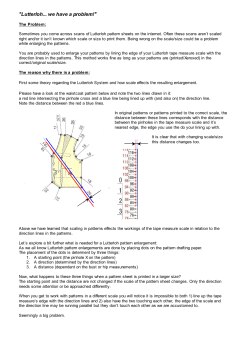
LaToya Franklin, ATC, CKTP
LaToya Franklin, ATC, CKTP Dr. Pascoe Dr. Gladden Dr. Sefton Kinesio® Tape Association Kenny Howard Fellowship Shoulder Anatomy What is Kinesio® Tape? What the research says… Current Study STATIC STABILIZERS: Ball and socket joint Large humeral head and small glenoid articular surface Ligaments of GH joint help provide more stability DYNAMIC STABILIZERS: Rotator cuff Supraspinatus Infratspinatus Teres minor Subscapularis Primary function to guide and stabilize glenohumeral joint “Kinesio Taping® is extremely versatile in its ability to re-educate the neuromuscular system, promote lymphatic flow, reduce pain, enhance performance, prevent injury, and promote injury resolution” ~ Kenzo Kase 100% cotton Latex free Acrylic heat activated adhesive Water resistant 130-140% elasticity Thickness and weight similar to skin Lasts 3 to 5 days Kase et al. (1996) stated Kinesio® Tape should: Create homeostasis and balance Increase fluid exchange Decrease edema Equalize temperature Five main physiological effects: Skin Circulatory/lymph Fascia Joint Muscle PROPOSED EFFECTS ON MUSCLE: Reduce pain Increase range of motion Normalize length/tension ratios to create optimal force Assist tissue recovery Reduces fatigue Halseth et al. (2004) studied Kinesio® Tape and ankle proprioception: 30 healthy participants Pre and post test With and without tape Plantar flexion and inversion No significant change Kase and Hashimoto (1998), Kinesio® Tape’s effectiveness on blood flow Doppler machine to measure blood flow, before and after Kinesio® Tape of 9 subjects No significant changes in healthy subjects Significant changes found in subjects with physical disorders Fu et. al (2008) observed the effect of Kinesio® Tape on muscle strength: 14 healthy male and female athletes Quadriceps and hamstring strength Three conditions: Without taping With taping With taping after 12 hours Results were not significant Thelen, Dauber, and Stoneman (2008),Kinesio® Tape effect on shoulder pain: 42 participants with RTC tendonitis/impingement 2 groups KT therapeutic/KT sham Self reported pain and pain free AROM measured KT therapeutic group showed immediate improvement in ROM Why? Few studies involve the shoulder Little research performed on the effects of taping on the shoulder Limited Kinesio® Tape research/Studies vary on Kinesio® Tape claims Objective To see if the suggested Kinesio® Tape protocol produces measurable effects (increased ROM, increased force production, increased blood flow) compared to Sham Tape after muscle fatigue Healthy males and females Between the ages of 20 – 25 (mean 21.8 ± 1.2 years) 16 participants 12 female 4 male Exclusion criteria Circulatory problems Local infection Recent wounds Smokers Shoulder injuries/problems within the past year Dynamic Infrared Thermography (DIRT) Passive, noninvasive temperature sensing device Measures changes in radiant body surface temperature Goniometer Measure active range of motion (AROM) Flexion Extension Abduction Internal/external rotation Load Cell transducer which converts force into a measurable electrical output Kinesio® Tape and Sham Tape Visual Analogue Scale (VAS) 100mm scale used to record pain intensity experienced after muscle fatigue Shoulder Pain and Disability Index (SPADI) Questionnaire used to asses changes in shoulder discomfort DAY 1 Informed Consent, PAR-Q, health questionnaire 2. Group selection 3. Weight measurement 4. DIRT equilibration/scans 1. DAY 1 5. AROM measures DAY 1 6. Force measures Internal Rotation External Rotation DAY 1 7. Tape Application 3 1 2 Kinesio® Tape Sham Tape DAY 1 8. DIRT equilibration/scans 9. AROM measures 10. Force measures 11. Fatigue protocol DAY 1 12. DIRT equilibration/scans 13. AROM measures 14. Force measures 15. VAS/ SPADI DAY 2 and DAY 3 DIRT equilibration/scans 2. AROM measures 3. Force measures 4. VAS/SPADI 1. Descriptive statistics and confidence intervals 3x5 (treatment x time) repeated measures MANOVA with a follow up ANOVA and ttests Analysis performed using SPSS, significance level set at a priori to p=0.05 DIRT statistically significant effect both in group and within subjects in all groups after Day 1 (F 1,15 = 14.832, p=0.002) statistically significant effect within subjects in Kinesio® Tape (F 4, 12 = 2.789, p= 0.026) and Sham Tape (F 4, 12 = 2.789, p= 0.026) DIRT Day 1: each group showed a gradual increase in temperature Day 1 to Day 3: Kinesio® Tape showed a 0.6°C temperature increase Sham Tape showed a 0.2° C temperature increase AROM AROM together showed no statistical significance between group or within subjects from Day 1 to Day 3 External rotation showed statistical significant effect with subjects from Day 1 to Day 3 (F 4,12 = 2.097, p=0.036) AROM Day 1 to 3: Kinesio®Tape showed 1.5° increase in external rotation from Day 1 to Day 3 Sham Tape showed 1.2 ° increase in external rotation from Day 1 to Day 3 Force Internal rotation showed a statistical significant effect between all groups with tape after Day 1 (F 4, 12 = 4.44, p=0.20) Day 1: No tape showed 2.6 N decrease in force Kinesio® Tape showed 2.8 N decrease in force Sham Tape showed 3.3 N decrease in force Pain and Discomfort VAS showed a statistical significant effect between all groups from Day 1 to Day 3 (F 2, 14= 4.183, p=0.038) Day 1 to Day 3: No tape .5 decrease in VAS score Kinesio® Tape .5 decrease in VAS score Sham Tape .3 decrease in VAS score Primary goal was to determine if Kinesio® Tape was effective in producing physiological changes that improved shoulder joint and muscle function after muscle fatigue Results agree with previous research in which Kinesio® Tape showed improvement in blood flow and range of motion Results also concurred with previous research that showed no significant increase in muscular activity with the use of Kinesio® Tape Although results show statistical significance they may not be clinically meaningful Low sample size Study may not have accurately depicted how Kinesio® Tape would work during athletic participation Study solely looks at shoulder and may not be indicative of how Kinesio® Tape would work in other parts of the body Limited research on the effects of Kinesio® Tape and its uses Study provided a small picture of the physiological and functional effects of Kinesio® Tape No indication Kinesio® Tape showed greater improvement in blood flow and AROM as compared to the Sham Tape Assessment of Kinesio ® Tape effects on blood flow, ROM, and force production in participants with shoulder pathologies Dr. Pascoe Dr. Sefton Dr. Gladden Dr. Weimar Ceren Yarar Bonni Messner Marie Lackamp Ande Sumner Remi Onifade Rehab Works Kenny Howard Fellowship Kinesio ® Tape Association Kenny Howard Fellows Warrior Athletic Trainers Auburn University students 1. 2. 3. 4. 5. 6. 7. Kinesio Taping Association Website. Available at: www.kinesiotaping.com. Halseth T, McChesney JW, DeBelsio M, Vaughn R, Lien J. The effects of kinesio taping on proprioception at the ankle. Journal of Sports Science and Medicine. 2004; 3: 1 -7. Thelen MD, Dauber JA, Stoneman, PD. The clinical efficacy of Kinesio Tape for shoulder pain: A randomized double-blinded, clinical trial. Journal of Orthopaedic & Sports Physical Therapy. 2008; 38(7): 389 -395. Branstiter G. The use of Kinesio Tape for the management of postsurgical scar tissue. Case study. Kase K, Hashimoto T. Changes in the volume of peripheral blood flow by using Kinesio Taping. Kinesio Tape Association Website. 1998. Osterhues DJ. The use of Kinesio Taping in the management of traumatic patella dislocation. A case study. Physiotherapy Theory and Practice. 2004; 20: 267 -270. Fu et. al. Effect of Kinesio Taping on muscle strength in athletes-a pilot study. Journal of Science and Medicine in Sport. 2008; 11: 198 – 201.
© Copyright 2025









